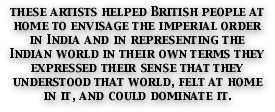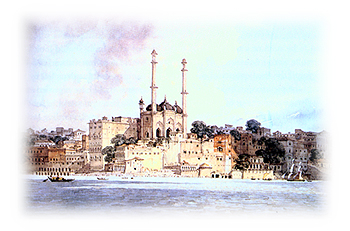|
In the second half of the Eighteenth Century a remarkable group of portrait painters moved to India. These painters looked for patronage among the European community in the major cities. To make a living, they painted portraits of East India Company officials, from the Governor-General downwards, or moved to Indian courts to paint princes, their relatives, and palace officials. But they also painted pictures for their own pleasure - of Indians, Indian landscapes, and exotic curiosities.
There are a number of reasons why these portraitists did well in India. The British were increasingly aware of being involved in grand designs - commercial, military and political - in the subcontinent. Public buildings, if they wer to emulate the style of those at home, required paintings: the dignity of law courts, for example, would be enhanced by portraits of judges and chief justices. Many officials and officers sought to commemorate their period in India. Others wished to give presents to family or friends. Societies commissioned paintings of leading patrons and portraits of the leading grandees were painted to be presented to the royal court, leading aristocrats, or major institutions at home.
The courts of the Indian princes were lucrative sources of work for similar reasons. There was a genuine fascination with the novelty of western art - its realism, perspective, and handling of colour - but, like the British, the indigenous rulers sought to enhance their style and importance through grand images. Moreover, a convention of present-giving developed whereby the Governor-General and other leading officials like the British Resident presented portraits of themselves and often received images of the Prince in return.
Such portraiture was not merely an extension of European styles and conventions into a new environment. The subjects of paintings were, it is true, often placed in stylized architectural settings - against classical columns, a grand balcony, or hanging drapes - which could equally have worked in Europe. But others appeared against identifiable Indian scenes, featuring indigenous vegetation, backgrounds symbolizing the profession of the sitter (for example, a sepoy camp behind a British officer), or local buildings, both European and Indian. Even more interestingly, British subjects were sometimes painted with their Indian servants or with the 'bibis' (concubines) and their children. These portraits gave the artists further opportunities to dwell upon the beauty of carpets, clothing, jewellery, hookahs and other examples of Indian crafts, garden pavilions, and the like. By these means, the Indian portraits, like landscapes painted in the colonies, extended the range and taste of Eighteenth Century art.
Indian portraits also acquired political significance. The paintings of Warren Hastings, Governor General from 1774 to 1785, were generally informal or, when he was painted with his family, were in the style of the English country parkland group portrait. Later in the century, however, portraitist were very much aware of painting a magnificent British court, almost seeking to match its Indian counterparts. Lord Mornington, later the Marquess Wellesley, was convinced that India could only be ruled from a great palace and in the grandest style. The many portraits he commissioned sought to convey this sense of a British court transplanted to the east and Wellesley was depicted in quasi-monarchical stance, magnificently robed and adorned. Later in the century the regal style became the standard for all the portraits of viceroys, now often accompanied by their vicerines, splendidly attired and bejewelled.
From the 1840s painted portraits began to be replaced by photographs. Paintings were now restricted to the most senior of the British rulers in India and their function was almost exclusively a ceremonial and political one.
|
|
India extended the range of British landscape as well as of British portraiture. While some portraitists also painted landscapes, other painters arrived with the intention of specializing in that field. These landscape painters generally painted not only scenery, but also Indian architecture, palaces, forts, temples, and village scenes. In such paintings human figures often become incidental - providers of scale, indicators of the exotic, but not individually realized personalities.
At the end of the Eighteenth Century Indian landscapes were painted according to the conventions of European landscape art, especially those of the 'picturesque'. Picturesque art placed its emphasis not on realistic representation, but on the creation of an arranged landscape that fulfilled certain expectations. Thus a variety of elements, often derived from on-the-spot sketching, would be brought together in a satisfying composition that met both a somewhat restrained sense of what was judged to be sublime and also the painter's idea of what India should look like. Picturesque conventions were to be remarkably durable in representations of India, lasting until the final quarter of the Nineteenth Century. India as depicted by the artists of the picturesque had some of what Europeans would have regarded as its exotic elements taken out of it. Indian architecture, for instance, was either shown in conventionally picturesque ruins or had its (to European eyes) startling lack of symmetry reduced to symmetrical forms. Nevertheless, these painters were enthralled by Indian vegetation, by the details of buildings and their sculpture, as well as by aspects of Indian ceremony. Though the publication of their works as engravings in major books of illustrations, they made available to a wider public some understanding of the appearance of India and above all of its architectural inheritance. They were the forerunners of the major Nineteenth Century projects for discovering, drawing and photographing the Indian architectural and sculptural traditions which helped to uncover the sequence and history of the more distant Indian past. The convention of the picturesque finally lost its hold on British representations of Indian scenes late in the Nineteenth Century, when it was replaced by what purported to be a more realistic style, often stressing what seemed to be an exotic India.
|


